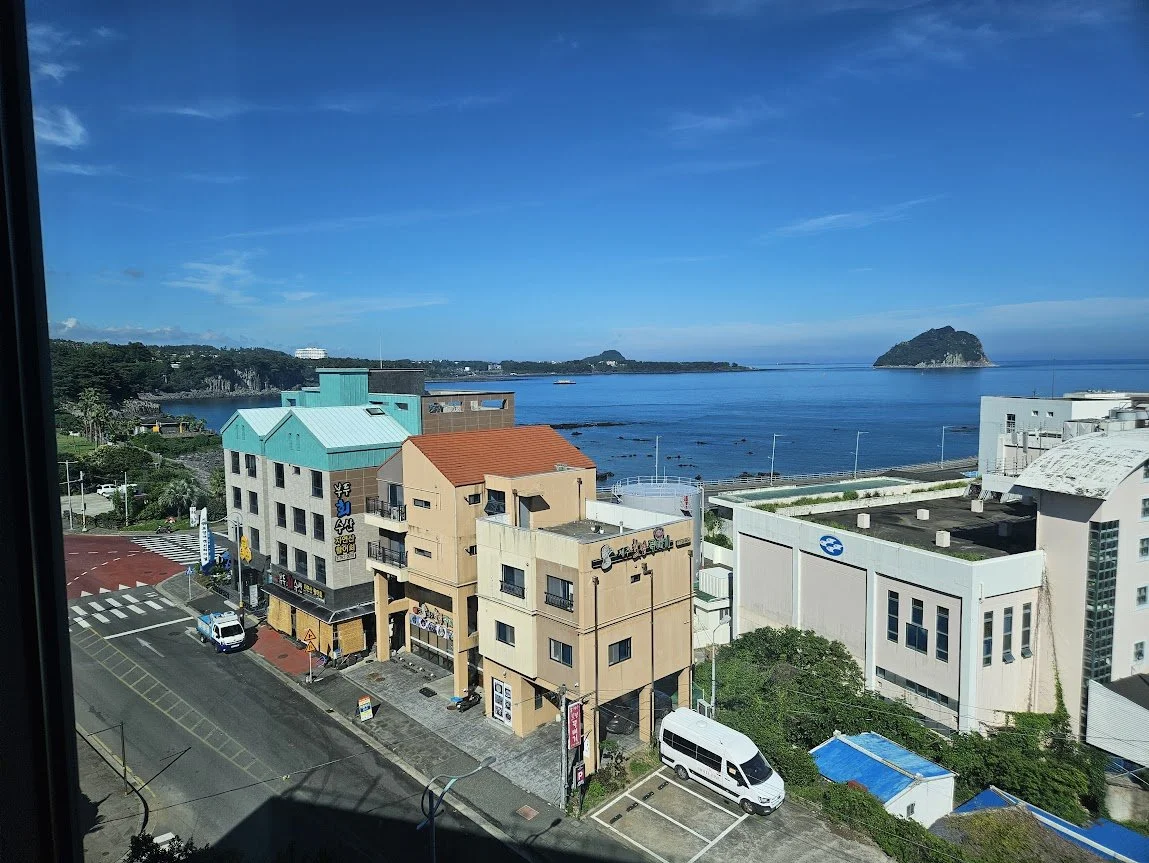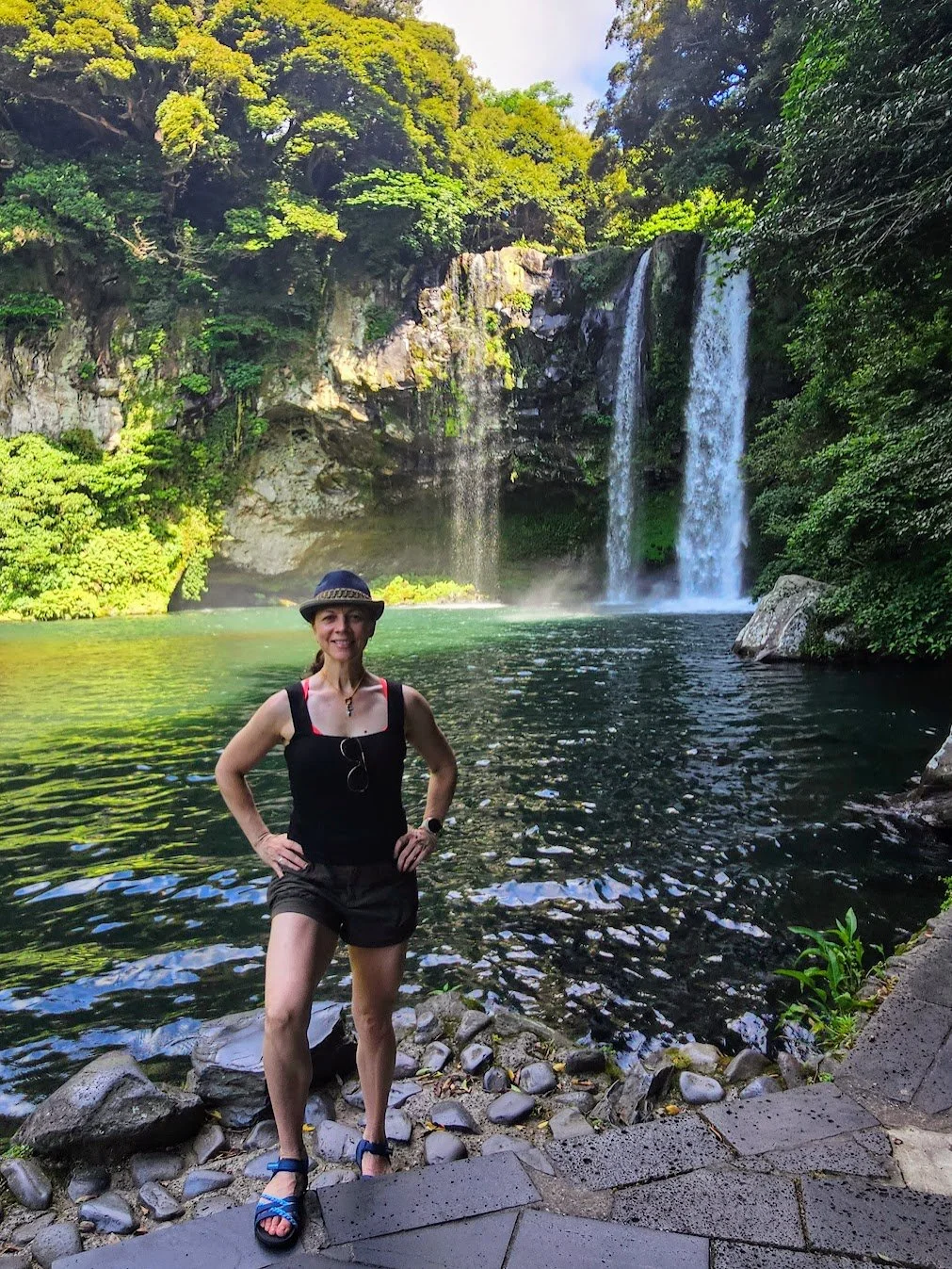The haenyeo! They’re everywhere!
I am finally writing from Jeju Island, South Korea! After a lot of flying and a layover in Beijing (why not Seoul, you ask? Airlines are weird and it was somehow faster and less complicated this way), I arrived on June 30th in the afternoon. I am staying in the city of Seogwipo, on the southern and opposite side of the island from the airport. It is the second largest city on Jeju, and much larger in population than I had imaged from my research. This is definitely the busy tourist season for Jeju; it is considered “the Hawaii of Asia”, at least to the Chinese, Koreans, and Japanese, as a vacation spot. I can certainly see why: palm trees, beaches, unique rock formations, unique museums (like Hello Kitty and Action Figures and Seashells), and lots of resorts. My room with a view certainly can’t be beat.
My hotel room view in Seogwipo, Jeju. The next morning I could see haenyeo in the harbor.
But you all know why I’m here. I’m here for the women. And their spleens. Yes, those freaking amazing spleens that let them be functionally more seal than human for the purposes of freediving. I was hoping to come across a haenyeo workshop/base camp/whatever they call it (I don’t yet know the terminology) before I meet up with the group I’ll be learning from, the Nomad Her Haenyeo Camp on Friday July 4th. But I didn’t expect to find them as easily and ubiquitously as I did. I set out in the morning to find the Saeyeongyo Bridge connecting the mainland to Saeseom Island for a nature walk and came across a building that had all the markings of haenyeo activity: collecting nets, round orange buoys used as floats for their collecting nets, running water tanks for fresh catch, and a giant mural with haenyeo on it was a slight giveaway.
The Saeyeongeyo Bridge, with haenyeo diving in the water to the left!
And then I saw them! Probably a dozen or so, in the water along the rocky shores next to the Saeyeongyo Bridge, in what looked like maybe 15-20 feet of water. They would stay down for a few seconds at a time, their flippers prominently up in the air just as they dove, and would make a whistling sound to each other just before dives; I will most certainly learn all about the significance of this on Friday. I watched them for about an hour, decided to visit a waterfall for a bit, then returned about an hour later. They were mostly still diving, though three came in, put their catch in the tanks, and immediately went into warm showers inside. I briefly greeted one haenyeo, who smiled and greeted me back in Korean. My Korean is limited to about 4 useful words and zero ability to read any characters. On Friday, the coordinator of Nomad Her (the granddaughter of a haenyeo) will be translating our conversations, so I’ll wait until then for questions and try to be the least annoying of a dumb dumb overexcited tourist as possible.
One of the haenyeo bringing in her catch.
The haenyeo harvest: conch, sea squirts, sea cucumber, and abalone.
I was so happy and grateful to see the haenyeo in action so soon after arriving. Before getting back to my hotel room, I saw four other haenyeo at a different location, right outside my hotel, and two of them zoomed by me on scooters with their catch in baskets! It hadn’t occurred to me that they would just zip all over the island looking for the best spots, but of course they would. They are everywhere. My next thought was to be back to see them again the next day. Should I get a scooter too? Should I get out there early in the morning snorkeling and try to impress them with my skills in hopes that they adopt me into their clan? Settle down, Mer. You’re here to be a journalist, not a Wes Anderson movie.
Something I found really interesting is how much modern fishing practices - large scale fishing boats - and ancient fishing practices - the haenyeo - are operating side-by-side on Jeju. Granted, they appear to have different ranges of catch; haeneyo only catch seaweed and invertebrates, which may not be as harvestable on large commercial scales on Jeju as compared to vertebrates (fish). I want to know more about this evolving relationship into the 21st century, especially since, from what I have read thus far, the South Korean government is invested in helping to preserve the haenyeo tradition. While they are certainly ubiquitous - they are everywhere! And they are culturally represented all over the place - they are also overwhelmingly in their 70s and 80s. Who will replace them?
A haenyeo statue in Seogwipo.
My other adventures today took me to two beautiful waterfalls in Seogwipo. Because Jeju is a volcanic island, it is primarily a basalt formation and so has many caves, tunnels, and waterfalls. I visited two: Cheonjiyeon and Jeongbang, the latter of which falls into the sea. There is such lush and spectacular greenery everywhere you look, straight into the middle of a busy city, and with fresh water running out of the ground throughout the island. The black basalt makes for superb pumice stone, but also has been shaped into “Dol hareubang”, statues that remind me a little of Easter Island’s Moai. They are found in front of homes and businesses as protection from bad spirits.
Me in front of Cheonjiyeon Falls, Seogwipo.
Lots of Dol hareubang, absolutely zero evil spirits here.
What’s more in store for today? Perhaps another run (heat tolerance training…), maybe a visit to a dive shop to see about an impromptu SCUBA adventure in the next day or so, though I’m greatly enjoying blogging from this coffee shop and watching two haenyeo who have been in the water for about 4 hours now. Also must make it to the Shell Museum at some point. There is no shortage of things to do in Seogwipo.
Did I mention they love karaoke on this island?







